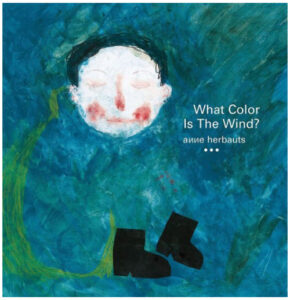 What Color Is the Wind?
What Color Is the Wind?
By Anne Herbauts
Translated by Claudia Zoe Bedrick
Enchanted Lion Books
$19.95
ISBN: 978-1-59270-221-3
Ages 5 and up
On shelves now
I’m going to have a hard time of it when my kids grow up. When I had them I swore up, down and sideways that I wouldn’t turn into the kind of blogger that declares that a book is good or bad, based solely on the whims of my impertinent offspring. For the most part, I’ve kept that promise. I review picture books outside of their influence, though I’m always interested in their opinions. Indeed, these opinions, and the sharp eyes that inform them, are sometimes not what I’d expect at all. So while I’ve never changed my opinion from liking a book to not liking it just because it didn’t suit my own particular kids’ tastes, I have admittedly found a new appreciation for other books when the children were able to spot things that I did not. What Color Is the Wind? is a pretty good example of this. I read the book at work, liked it fine, and brought it home for a possible review. My daughter then picked it up and proceeded to pretty much school me on what it contained, front to finish. Had I noticed the Braille on the cover? No. Did I see that the main character’s eyes are closed the whole time? No. How about the tactile pages? Did you notice that you can feel almost all of them? No. For a book that may look to some readers as too elegant and sophisticated to count as a favored bedtime story, think again. In this book Anne Herbauts proves beyond a shadow of a doubt that a distinct European style is engaging to American children when their parents give it half a chance. Particularly when tactile elements are involved.
 “We can’t see the wind, / we hear what it brings. / We can’t hear the wind, / we see what it brings.” The book begins with a question. A boy, his eyes closed, walks behind the cutout of a house. “What color is the wind? asks the little giant.” As he walks along, various plants, birds, animals, and inanimate objects offer answers. A wolf says the wind’s color is “the dark smell of the forest” while a window disagrees and says it’s “the color of time.” Everything that answers the little giant has a different feel on the page. The stream feels like consecutive ripples emanating from a dropped pebble, the roots of an apple tree like long, thin rivulets. At last the little giant encounters something that he senses is enormous. He asks his question and an enormous giant replies, “It is everything at once. This whole book.” He flips the book’s pages with his thumb so that they fly, and you the reader do the same, feeling the wind the book is capable of producing with its thick, lustrous pages. The color of the wind. The wind of this book.
“We can’t see the wind, / we hear what it brings. / We can’t hear the wind, / we see what it brings.” The book begins with a question. A boy, his eyes closed, walks behind the cutout of a house. “What color is the wind? asks the little giant.” As he walks along, various plants, birds, animals, and inanimate objects offer answers. A wolf says the wind’s color is “the dark smell of the forest” while a window disagrees and says it’s “the color of time.” Everything that answers the little giant has a different feel on the page. The stream feels like consecutive ripples emanating from a dropped pebble, the roots of an apple tree like long, thin rivulets. At last the little giant encounters something that he senses is enormous. He asks his question and an enormous giant replies, “It is everything at once. This whole book.” He flips the book’s pages with his thumb so that they fly, and you the reader do the same, feeling the wind the book is capable of producing with its thick, lustrous pages. The color of the wind. The wind of this book.
The Kirkus review journal said that this book was, “ ‘The blind men and the elephant’ reworked into a Zen koan” and then proceeded to recommend it for 9-11 year-olds and adults. I’m fairly certain I disagree with almost every part of that. Now here’s the funny part. I didn’t read this review before I read the book. I also didn’t read the press release that was sent to me with it. When I read a book I like to be surprised by it in some way. This is usually a good thing, but once in a while I can be a bit dense and miss the bigger picture. As I mentioned before, I completely missed the fact that this book was an answer to a blind child who had asked Anne Herbauts the titular question. I just thought it was cool that the book was so much fun to touch. Embossing, debossing, die-cuts, lamination, and all kinds of surfaces give the book the elements that make it really pop. As I read it in the lunchroom at work, my co-workers would peer over my shoulders to coo at what they saw. All well and good, but would a kid be interested too? Kirkus says they’d have to be at least nine to grasp its subtleties.
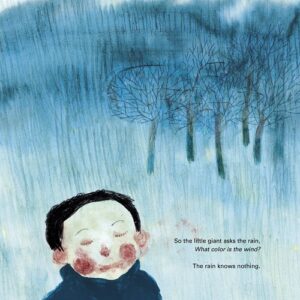 Obviously my 5-year-old daughter likes the book but she’s just one kid. She is not a representative for her species (so to speak). That said, this book just drills home the advantage that physical books have over their electronic counterparts: the sensation of touch. Play with a screen all day if you like, but you will never be able to move your fingers over these raised dots of rain or the rough bark of a tree’s trunk. As children become more immersed in the electronic, they become more enamored of tactile books. The sensation of paper on skin has yet to be replicated by our smooth as silk screens. And this will prove true with kids on the younger end of the scale. I’ll agree with Kirkus about the adult designation, though. When I worked for New York Public Library there was a group of special needs adults that would come in that were in need of tactile picture books. We would be asked if we had any on hand that we could hand over to them in some way. There were a few, but our holdings were pretty limited (though I do remember a particularly keen tactile version of The Very Hungry Caterpillar that proved to be a big hit). Those kids would have loved this book, but children of all ages, and all abilities, would feel the same way about it. Kids are never too old for tactile picture books. As such, you could use this book with Kindergartners as well as fifth graders. Little kids will like the fun pictures. Older kids may be inspired by the words as well.
Obviously my 5-year-old daughter likes the book but she’s just one kid. She is not a representative for her species (so to speak). That said, this book just drills home the advantage that physical books have over their electronic counterparts: the sensation of touch. Play with a screen all day if you like, but you will never be able to move your fingers over these raised dots of rain or the rough bark of a tree’s trunk. As children become more immersed in the electronic, they become more enamored of tactile books. The sensation of paper on skin has yet to be replicated by our smooth as silk screens. And this will prove true with kids on the younger end of the scale. I’ll agree with Kirkus about the adult designation, though. When I worked for New York Public Library there was a group of special needs adults that would come in that were in need of tactile picture books. We would be asked if we had any on hand that we could hand over to them in some way. There were a few, but our holdings were pretty limited (though I do remember a particularly keen tactile version of The Very Hungry Caterpillar that proved to be a big hit). Those kids would have loved this book, but children of all ages, and all abilities, would feel the same way about it. Kids are never too old for tactile picture books. As such, you could use this book with Kindergartners as well as fifth graders. Little kids will like the fun pictures. Older kids may be inspired by the words as well.
“Mom,” said my daughter as we went down the stairs for her post-reading, pre-brushing, nighttime snack. “Mom, you know the wind doesn’t have a color, right?” My child is a bit of a literalist. She’s the kid who knew early on that magic wasn’t real and once told me at the age of three that, “If ‘please’ is a magic word, it doesn’t exist.” So to read an entire book, based on the premise of seeing a color that couldn’t possibly be real, was a stretch for her. Remember, we read this entire book without really catching on that the little giant was blind. I countered that it was poetry, really. Colors were just as much about what they looked like as what they felt like. I asked her what blue made her feel, and red. Then I applied that to the emotions we feel about with the wind, which wasn’t really an analogy that held much water, but she was game to hear me out. “It’s poetry”, I said again. “Words that make you feel something when you read them.” So, as she had her snack, she had me read her some poetry. We’ve been reading poetry with her snack every night since. So for all that the book could be seen to be a straightforward picture book, to me it’s as much an introduction to poetry as anything else.
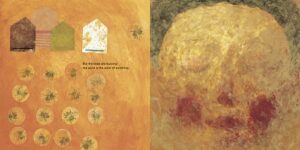
As for the art, I’ll admit that the combination of the style of art, the image on the cover, and the fact that the book is softcover and not hardcover (a cost-saving measure for what must be a very expensive title for Enchanted Lion Books to publish) did not immediately appeal to me. There’s no note to explain what the medium is and if I were to guess I’d say we were looking at crayons, mixed media, thick paints, colored pencils, ink blots, pen-and-inks, and more. Ironically, I really began to gravitate to the art when the little giant wasn’t stealing my focus. Nothing is intricately detailed, except perhaps the anatomy of honeybees or the raised and bumpy parts of the book. At the same time, for a book that celebrates touch, poetry, and physical sensation, the colors are often bright and lush. Whether it’s the blue watercolors of rain over trees or the hot orange that emanates from the page like a sun, Herbauts is simultaneously rendering illustrations obsolete with the unique format of What Color is the Wind? and celebrating their visual extremes.
I tend to give positive reviews to books that exceed my expectations. That’s just the nature of my occupation. And while I do believe that there are elements to this book that could be clearer or that there must have been a book jacket choice they could have chosen that was more appealing than the one you see here, otherwise I think this little book is a bit of a wonder. Deeply appealing to children of all ages, to say nothing of the adults out there, with so many uses, and so many applications. It reminds me of the old picture books by Bruno Munari that weren’t afraid to try new things with the picture book format. To get a little crazy. I don’t think we’ll suddenly see a big tactile picture book craze sweep the nation or anything, but maybe this book will inspire just one other publisher to try something a little different and to take a risk. Could be worth it. There’s nothing else like this book out there today. More’s the pity.
On shelves now.
Source: Final edition sent from publisher for review.
Like This? Then Try:
Professional Reviews:
Misc: A deeper look at some of the art over at Seven Impossible Things Before Breakfast

Tell me and tell me true, what do the following have in common?

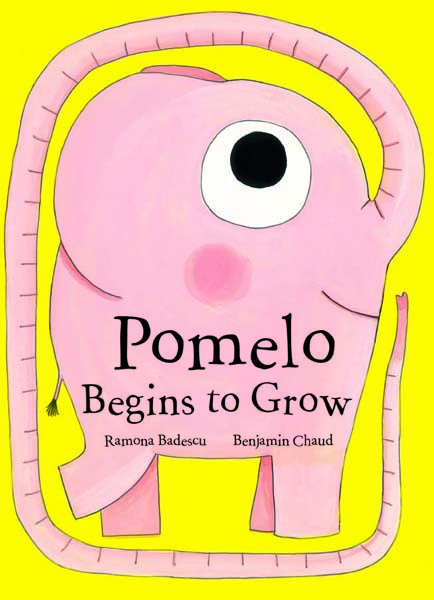
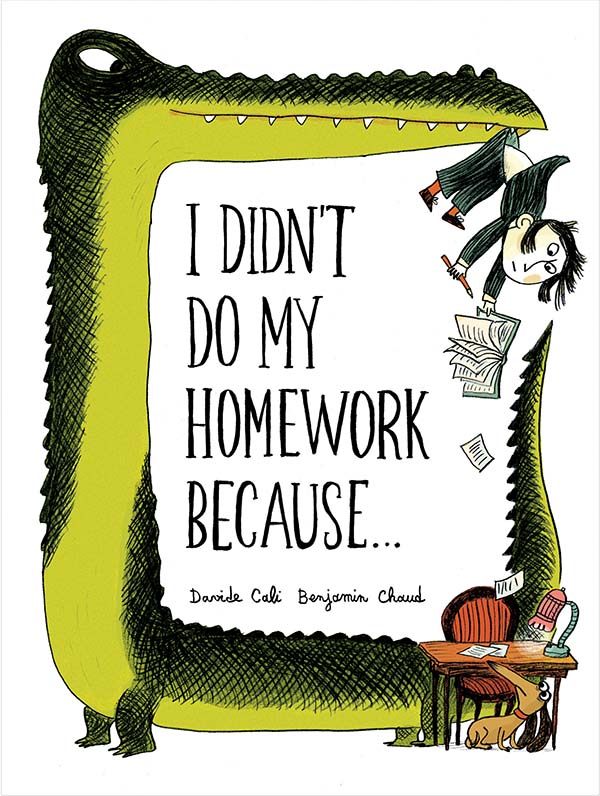
From the title of this post you have no doubt concluded that they all share the same illustrator. However, had you asked me prior to my recent meeting with French artist Benjamin Chaud, I don’t know that it would have necessarily occurred to me.
Over the years I’ve noticed Chaud’s work, but only in the vaguest possible sense. You see, I’m a big fan of the Pomelo books by Ramona Badescu, published by Enchanted Lion Books here in NYC. Each title stars an odd pink elephant-type of character. Pomelo is a strange little fellow, and I do mean little since his best friends include snails and dandelions. He also sports a hopeless crush on a frog in a case of unrequited pachyderm/amphibian love. Kermit and Piggy have nothing on Pomelo. The books that have made it to American shores include:
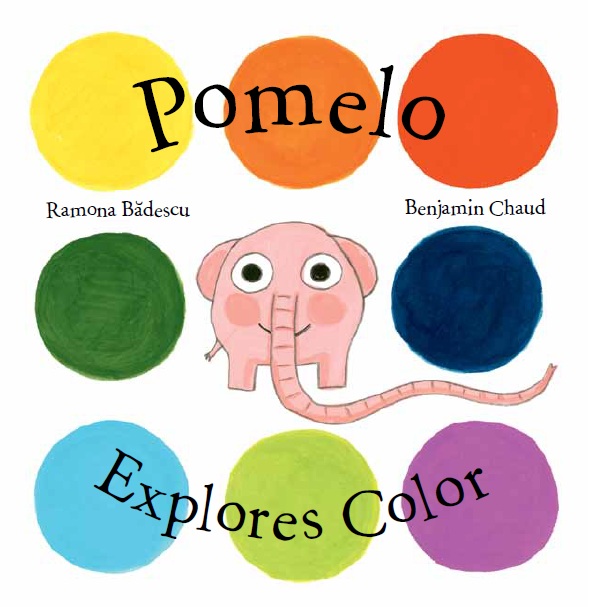
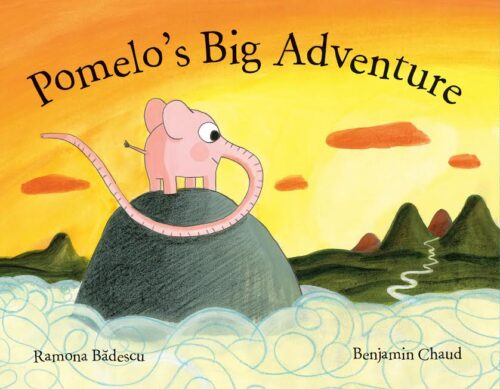
But my favorite by far has to be . . .

Because, quite frankly, if you want the kookiest opposite book of all time, this is it, folks.
Well, I was pleased as punch to learn that Mssr. Chaud was in town for ten days, visiting the States and the kids that are here. I swear, when Herve Tullet moves to Brooklyn he’d better embrace a role as host for all his incoming countrymen. Publisher Claudia Zoe Bedrick invited me to nosh and meet Benjamin and so we did! At Le Pain Quotidien, no less.
So what does your typical French artist do when visiting New York City? Well there’s MOMA, of course. And Central Park. There’s Rockefeller Center and bookstores like Book Court and, naturally, NYPL’s current exhibit The ABC of It. But the best part was hearing about his visits with the kids. Chaud took a trip to The Lycée Français de New York, a bilingual school for kids of all ages. While there he met with 106 “very enthusiastic” children and created art with them. And here we can see the results of his visit to Book Court:



As you can see, Pomelo comes easily to the man’s pencil tip. So easy, in fact, that he had time to create some fun little off-the-wall images of Pomelo in his own shoes:
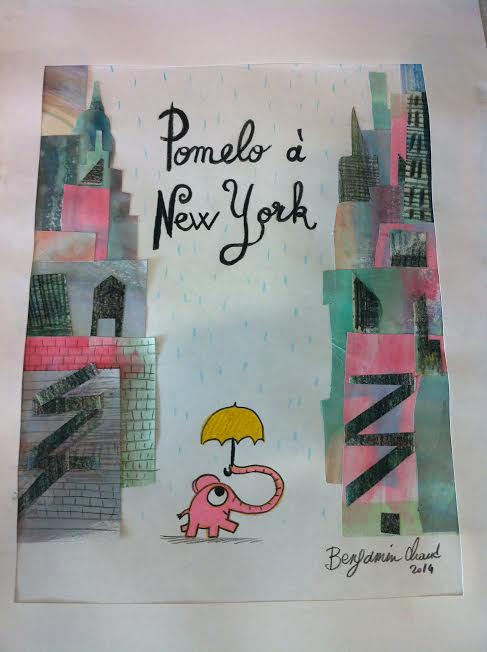
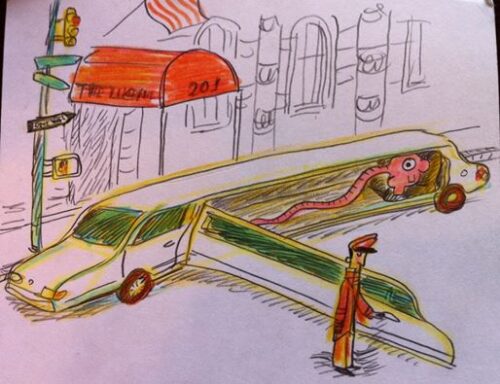
I love these.
Talking about Pomelo naturally lead to a discussion of the differences between French and American picture books. Claudia had some interesting things to say about the changes made to the aforementioned Pomelo’s Opposites when bringing to the book to the States. We talked about changing certain images from “good” and “bad” to “right” and “wrong”. Or why the opposite of cucurbit made the final cut. And we talked about Pomelo himself and his journey. Since his true author is Ramona Badescu this was all conjecture, but we talked about what it would mean if in his last book he went so far as to die. And then we got to thinking about picture book characters in series and if any of them have ever died. At the time I couldn’t come up with any, but since then I was able to think up one. The Sally books by Stephen Huneck followed a Labrador on various adventures, finally ending with Sally Goes to Heaven. But it’s a bit of a rarity.
So we talked about the approach of death in various books for small children. The European picture books have a comfort level with death and dying we lack here in the States. Here in the U.S. you can discuss death, but only if it is the ONLY topic at hand. In other countries, death can be far more of the narrative. It was an illuminating conversation, worthy of a post in and of itself.
In the end, I bid farewell to Benjamin Chaud and thanked him for his time. With the latest Pomelo book out this year (Pomelo’s Big Adventure) as well as a sequel to last year’s The Bear’s Song (you can see it in my recent Chronicle librarian preview) he’s certainly slated to become better and better known. And for that, I am well and truly pleased.
Thanks to Claudia for the meeting and to Benjamin for being willing to meet.

 My Dad Is Big and Strong, But…: A Bedtime Story
My Dad Is Big and Strong, But…: A Bedtime Story
By Coralie Saudo
Illustrated by Kris Di Giacomo
Translated by Claudia Zoe Bedrick
Enchanted Lion Books
$16.95
ISBN: 978-1-59270-122-3
Ages 4-8
On shelves April 17, 2012
Few picture book titles come with qualifications. More often than not they are statements of strong purpose. I Can Do It Too or No, I Want Daddy. Declarative books with forthright ideas and messages for the preschool set. That’s all well and good, but sometimes you want a book that entices you to pick through its pages from the title onward. Now there is no doubt that My Dad Is Big and Strong, But… is a work of translation. From the minute you look at it it has all the signs. The drawings are fun and eclectic but they feel strangely . . . European, perhaps? And the art inside is a mix of mixed media photographs and graphite. Then there’s the story, which doesn’t end with that kooky twist we Americans almost require in books of this sort these days. Finally there’s that title that seems to float in mid-air without direction. Yes, there is no doubt left in your mind that this is a French translation, but there is also no doubt that it is one of the most charming and engaging picture books to hike down the pike in years. A story that upsets expectations but retains its heart, this is the perfect bedtime fare for any kiddo that rejects the very notion of going to sleep (and who has a sense of humor).
Our hero’s dad has many fine and outstanding qualities. He is big. He is strong. But he does have one significant flaw that’s hard to overlook. Every night it’s the same old story. When bedtime rolls around he just adamantly refuses to go. The only thing to do is to start out by reading him some stories. After two he’ll demand another but his son is having none of it. It’s straight to bed and a game of waiting until the dad’s asleep (if the son tries to go to bed early he’ll just have to contend with a wide awake dad barging into his room anyway). Finally he seems to be asleep but just as the son attempts to turn out the life he hears, “No, don’t do that! Leave the light on!” Because while his dad may be big and strong he’s also a bit afraid of the dark.
There’s an entire subgenre of picture books out there where expectations are upended to the delight of the child reader. I can think of four books off the top of my head where a character is scared about the first day of school and then turns out to be a teacher (Back to School Tortoise] by Lucy M. George was the latest). And Amy Krouse Rosenthal went to town with the idea in Little Pea (a pea refuses to eat his dinner of candy), Little Hoot (an owl wants to go to bed while his parents insist he stay up all night), and
 I was going through a box of new Candlewick releases the other day when I came across a charming little board book by the name of Peekaboo Baby. It’s your standard lift-the-flap reveal-the-baby number, the kind Karen Katz has perfected to an art. A person can’t have too many lift-the-flaps in the house, of course, particularly when the intended audience’s books suffer at a high casualty rate. While packing it away to test on my small fry I noticed the author’s name Sebastien Braun. It got me to thinking. The French . . . there’s no escaping them. Do we even want to? And do we, in fact, need them more than ever before?
I was going through a box of new Candlewick releases the other day when I came across a charming little board book by the name of Peekaboo Baby. It’s your standard lift-the-flap reveal-the-baby number, the kind Karen Katz has perfected to an art. A person can’t have too many lift-the-flaps in the house, of course, particularly when the intended audience’s books suffer at a high casualty rate. While packing it away to test on my small fry I noticed the author’s name Sebastien Braun. It got me to thinking. The French . . . there’s no escaping them. Do we even want to? And do we, in fact, need them more than ever before?
Here’s the thing. I first noticed the influx of French baby and board books into the American market last year. Hervé Tullet may have gotten the most attention for the Chronicle translation of his book Press Here, but Phaidon released his board books as well. Then there was Martine Perrin and the successful Albert Whitman releases of Look Who’s There! and What Do You See? Add in the picture book translations as well while you’re add it. One-namer Frenchmen like Barroux and Blexbolex have come to our shores as well.
 Then this month I learned that the French publisher Auzou was starting to publish books here in America for the small fry. Getting a peek at their titles I was very impressed by books like Wolf Are You There? by Eleonore Thuillier. A cheery book, it manages to contain everything from real shoelaces and buttons to snaps, velcro, and zippers, so that kids can practice those difficulties times other than when they need to get dressed. Auzou has a whole range of titles (including a scratch and sniff book!) and it looks like they’ll be here for a while. Last but not least I received in the mail a board book from Houghton Mifflin Harcourt entirely in French. It’s at my workplace at the moment, so I’ll tell you what the title was when I get back there, but it’s a beautiful little thing and it will prove very useful in the future.
Then this month I learned that the French publisher Auzou was starting to publish books here in America for the small fry. Getting a peek at their titles I was very impressed by books like Wolf Are You There? by Eleonore Thuillier. A cheery book, it manages to contain everything from real shoelaces and buttons to snaps, velcro, and zippers, so that kids can practice those difficulties times other than when they need to get dressed. Auzou has a whole range of titles (including a scratch and sniff book!) and it looks like they’ll be here for a while. Last but not least I received in the mail a board book from Houghton Mifflin Harcourt entirely in French. It’s at my workplace at the moment, so I’ll tell you what the title was when I get back there, but it’s a beautiful little thing and it will prove very useful in the future.
Here is the true crux of the matter. In my new capacity as NYPL’s Youth Materials Specialist I’ve had a chance to do something entirely new to me: I’m looking at census figures. I’m seeing where the immigration patterns in the city lay, which communities need one language or another from their local branches, the works. What I have noticed has surprised me. We’ve the same need for Spanish, Chinese, and Russian titles that we always have. There are even pockets in need of Italian, Hebrew, Tagalog, etc. here and there. What I could not have predicted, however, was the increasingly desperate need for French books for children. The reasons make perfect sense when you consider them. Immigrants from French speaking countries in Africa are routinely moving to New
 What Color Is the Wind?
What Color Is the Wind? “We can’t see the wind, / we hear what it brings. / We can’t hear the wind, / we see what it brings.” The book begins with a question. A boy, his eyes closed, walks behind the cutout of a house. “What color is the wind? asks the little giant.” As he walks along, various plants, birds, animals, and inanimate objects offer answers. A wolf says the wind’s color is “the dark smell of the forest” while a window disagrees and says it’s “the color of time.” Everything that answers the little giant has a different feel on the page. The stream feels like consecutive ripples emanating from a dropped pebble, the roots of an apple tree like long, thin rivulets. At last the little giant encounters something that he senses is enormous. He asks his question and an enormous giant replies, “It is everything at once. This whole book.” He flips the book’s pages with his thumb so that they fly, and you the reader do the same, feeling the wind the book is capable of producing with its thick, lustrous pages. The color of the wind. The wind of this book.
“We can’t see the wind, / we hear what it brings. / We can’t hear the wind, / we see what it brings.” The book begins with a question. A boy, his eyes closed, walks behind the cutout of a house. “What color is the wind? asks the little giant.” As he walks along, various plants, birds, animals, and inanimate objects offer answers. A wolf says the wind’s color is “the dark smell of the forest” while a window disagrees and says it’s “the color of time.” Everything that answers the little giant has a different feel on the page. The stream feels like consecutive ripples emanating from a dropped pebble, the roots of an apple tree like long, thin rivulets. At last the little giant encounters something that he senses is enormous. He asks his question and an enormous giant replies, “It is everything at once. This whole book.” He flips the book’s pages with his thumb so that they fly, and you the reader do the same, feeling the wind the book is capable of producing with its thick, lustrous pages. The color of the wind. The wind of this book. Obviously my 5-year-old daughter likes the book but she’s just one kid. She is not a representative for her species (so to speak). That said, this book just drills home the advantage that physical books have over their electronic counterparts: the sensation of touch. Play with a screen all day if you like, but you will never be able to move your fingers over these raised dots of rain or the rough bark of a tree’s trunk. As children become more immersed in the electronic, they become more enamored of tactile books. The sensation of paper on skin has yet to be replicated by our smooth as silk screens. And this will prove true with kids on the younger end of the scale. I’ll agree with Kirkus about the adult designation, though. When I worked for New York Public Library there was a group of special needs adults that would come in that were in need of tactile picture books. We would be asked if we had any on hand that we could hand over to them in some way. There were a few, but our holdings were pretty limited (though I do remember a particularly keen tactile version of The Very Hungry Caterpillar that proved to be a big hit). Those kids would have loved this book, but children of all ages, and all abilities, would feel the same way about it. Kids are never too old for tactile picture books. As such, you could use this book with Kindergartners as well as fifth graders. Little kids will like the fun pictures. Older kids may be inspired by the words as well.
Obviously my 5-year-old daughter likes the book but she’s just one kid. She is not a representative for her species (so to speak). That said, this book just drills home the advantage that physical books have over their electronic counterparts: the sensation of touch. Play with a screen all day if you like, but you will never be able to move your fingers over these raised dots of rain or the rough bark of a tree’s trunk. As children become more immersed in the electronic, they become more enamored of tactile books. The sensation of paper on skin has yet to be replicated by our smooth as silk screens. And this will prove true with kids on the younger end of the scale. I’ll agree with Kirkus about the adult designation, though. When I worked for New York Public Library there was a group of special needs adults that would come in that were in need of tactile picture books. We would be asked if we had any on hand that we could hand over to them in some way. There were a few, but our holdings were pretty limited (though I do remember a particularly keen tactile version of The Very Hungry Caterpillar that proved to be a big hit). Those kids would have loved this book, but children of all ages, and all abilities, would feel the same way about it. Kids are never too old for tactile picture books. As such, you could use this book with Kindergartners as well as fifth graders. Little kids will like the fun pictures. Older kids may be inspired by the words as well.

















I’m actually delighted that you sometimes use your children as readers. Every now and then I read a bunch of reviews for a book that adults are enchanted by–maybe the illustrations remind them of books when they were younger, or a particular moral is being taught, or the artist is particularly sophisticated and original…I order the book, read it to children, and receive a universal, “Huh?”
Of course there are books that really only work for a few kids, but the universal “Huh?”–where not one hand goes up, asking to check it out–always makes me wish I had my money back. If I had my way, every picture book would be taken to a school or day-care center and tried on kids before it’s published.
Agreed. And it’s been a real blow to my reviews, in a way, that I don’t have daily interactions with large groups of children anymore. In lieu of that I had to make a couple of my own. Still, two is not a representative sample so I hold myself back on using them too too often.